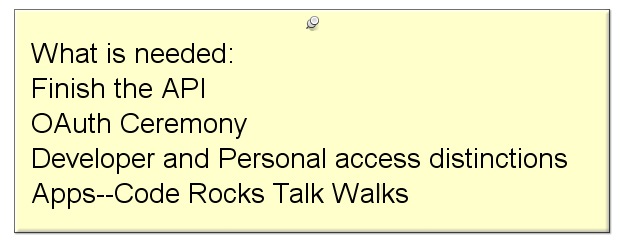Yesterday Google opened the curtain on Google Wallet. I think it’s the most important thing Google has launched since the search engine. Here’s why:
Reason #1: We’ve always needed an electronic wallet, especially one in our mobile phone. And, although others have tried to give us one, it hasn’t worked out for them, because…
Reason #2: We’ve needed one from somebody who doesn’t also have a hand in our pocket.  Google is the only company in the world that can pull this off, because it’s the only company in the world that lives to commodify exactly the businesses that desperately need commodification, and to await interesting consequences. I can’t think of a single company that’s better at causing tsunamis of commodification so they can join hundreds of other companies, surfing them to new shores. List the things Google does but doesn’t make money with, and you’ll have a roster of businesses that needed commodification. What Google looks for is what JP Rangaswami and I call because effects: you make money because of those things, not with them. (Note, not talking about “monetization” here. A subtle distinction.) A Google lawyer once told me this strategy was “looking for second and third order effects.” Same thing. Either way, they’re out to give us — and retailers we do business with — a hand. (But they will need to keep it out of our pockets, which includes data we consider personal. We’re the ones to say what that is, and others — including Google, Sprint, Citi and the retailers — need to respect that.)
Google is the only company in the world that can pull this off, because it’s the only company in the world that lives to commodify exactly the businesses that desperately need commodification, and to await interesting consequences. I can’t think of a single company that’s better at causing tsunamis of commodification so they can join hundreds of other companies, surfing them to new shores. List the things Google does but doesn’t make money with, and you’ll have a roster of businesses that needed commodification. What Google looks for is what JP Rangaswami and I call because effects: you make money because of those things, not with them. (Note, not talking about “monetization” here. A subtle distinction.) A Google lawyer once told me this strategy was “looking for second and third order effects.” Same thing. Either way, they’re out to give us — and retailers we do business with — a hand. (But they will need to keep it out of our pockets, which includes data we consider personal. We’re the ones to say what that is, and others — including Google, Sprint, Citi and the retailers — need to respect that.)
Reason #3: This reduces friction in a huge way. It’s not an exaggeration when Google says this on their Vision page for the project:
In the past few thousand years, the way we pay has changed just three times—from coins, to paper money, to plastic cards.
Now we’re on the brink of the next big shift.
What weighs your wallet down? What slows you down at checkout? Sometimes it’s pulling out cash, but most times it’s dealing with cards. In the last few years every store, it seems, has been piling on with loyalty cards and keyring tags. This last week Panera Bread started, and watching the results have been a clinic in business fashion gone wrong. The poor folks behind the counter are now forced to ask customers if they have a Panera bread card, and the customers have to either say no (and feel strange), or to produce one from their wallet or key ring. Yesterday I asked the person behind the counter how she liked it. “We don’t need it, and customers don’t want it,” she said. “We’re only doing it because every other store does it. That’s all.” That’s a pain in the pocket nobody needs.
Says Google,
Google Wallet has been designed for an open commerce ecosystem. It will eventually hold many if not all of the cards you keep in your leather wallet today. And because Google Wallet is a mobile app, it will be able to do more than a regular wallet ever could, like storing thousands of payment cards and Google Offers but without the bulk. Eventually your loyalty cards, gift cards, receipts, boarding passes, tickets, even your keys will be seamlessly synced to your Google Wallet. And every offer and loyalty point will be redeemed automatically with a single tap via NFC.
This assumes that the ecosystem will continue to support the kind of loyalty programs we have today. It won’t, because we won’t and that brings me to…
Reason #4: Now customers can truly relate with vendors. That is, if Google Wallet and participating retailers and other players welcome it. See, CRM — Customer Relationship Management — has thus far been almost entirely a sell-side thing. It’s how companies related with you, not how you related with them. They set the rules, they provided the cards, they put up the websites where you filled out long complicated forms, they send you the junk mail, and they do the guesswork about what you might want, usually because you’ve bought something like it before. But what if your phone has your shopping list? What if you want to advertise what you’re looking for, as a personal RFP for something you need right now, and may never need again? Think of this as advertising in reverse, or what Scott Adams (of Dilbert fame) calls “Broadcast Shopping”. This is one example of how …
Reason #5: Now demand can signal supply in great detail. Until now, about the only signals we could send were with cash, cards, and whatever might percolate up the corporate CRM chain from “social” CRM. There’s a lot here (see Brian Solis’ Converation Prism, for example, or follow Paul Greenberg). But those all depended on second (vendor) or third parties (all the petals in Brian’s prism, which actually looks more like a flower). They weren’t your signals. I see no reason why the open commerce ecosystem shouldn’t include that. Why should customers always be the dependent variables and not the independent ones? Speaking of independence…
Reason #6: Now you have your own pricing gun. You can tell a store, or a whole market, what you’re willing to pay for something — or what you might offer along with payment, such as information about your other relationships, or the fact that you just moved here and are likely to be shopping at this store more. (Or that you’re a high-status frequent flyer with another airline, and considering the same for this one.) Why not?
Reason #7: You can take your shopping cart with you. Back when e-commerce began, in 1995, my wife’s sister was the VP Finance for Netscape, so that company was something like family for us, making my wife (not a technical type) an early adopter. One of her first questions back then was one that exposes a flaw that’s been in e-commerce from the start: “Why can’t I take my shopping cart from one store to another?” At least conceivably, now you can. Let’s say you want to shop at Store B while you’re at Store A. This already happens when you scan a QR or a barcode with your smartphone to see if it’s cheaper at Amazon or something. But what if you want to be more sophisticated than that? The implications for retailers can be scary, but also advantageous. After all, retailers have physical locations, which Amazon doesn’t. Retailers can earn loyalty in ways that are as unique as each store, and each person working at a store.
Reason #8: Now you can bring your own data with you. Inevitably, you will have a personal data store, vault, locker, data wallet (yes, it’s already called that), trust framework — or other combination of means for managing and selectively sharing that data in secure, trustworthy and auditable ways. And your data doesn’t just have to be about shopping. Personal tracking and informatics are getting big now (read Quantified Self for more). That’s stuff we bring to the market’s table as well. The wallet in one’s phone seems a good way.
Reason #9: Now you can actually relate. When a customer has the ability to shop as well as buy, right in his or her wallet — and to put shopping in the contect of the rest of his or her life, which includes far more than shopping alone — retailers can discover advantages other than discounts, coupons and other gimmicks. Maybe you’ll buy from Store B because you like the people there better, because they’re more helpful in general, because they took your advice about something, or because they help your kid’s school. Many more factors can come into play.
Reason #10: Now you’re in a free and open marketplace. Not just the space contained by any store’s exclusive loyalty system. Nor in a “free” market that’s “your choice of captor” (which is one of the purposes of loyalty programs). Along those same lines…
Reason #11: You don’t have to play calf to every store and website’s cow. The reason you can’t take your shopping cart with you from store to store on the Web is that e-commerce normalized from the start on the calf-cow, slave-master architecture of client-server computing. This is what turned the Web from a peer-to-peer, end-to-end egalitarian greenfield into fenced-off ranchland where vendors built walled gardens for “consumers” who fed on the milk of each site’s exclusive offerings, and also got cookies that helped calf and cow remember each other, but which sometimes also tracked the calves as they wandered off into other gardens. It was a submissive/dominant system from the get-go, and has been flawed for exactly that reason ever since. Google Wallet, at least conceptually, gives you ways in which you can relate to anybody or anything, on your terms and not just theirs. And not just in the old commercial-Web-based calf-cow system. You can divine the bovine right in your pocket, and avoid or correct vendors trying to feed you tainted milk or tracking cookies.
I could go on, but I have a book to write and not much time left. But I consider Google Wallet a move of profound importance, even if it doesn’t work out, so I’m putting this list out there for us to correct, debate or whatever else we need to do . At the very least Google Wallet gives us one thing a BigCo is doing that can mesh well with what the VRM development community has been working on for the last few years. I hope the synergies will get everybody excited.
[Later, in August…] Some additional news:
Stay tuned.



 Companies and customers need to be able to deal with each other in two ways: as individuals and as groups.
Companies and customers need to be able to deal with each other in two ways: as individuals and as groups.




 Craig Burton
Craig Burton
 Here’s a great video
Here’s a great video